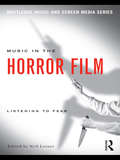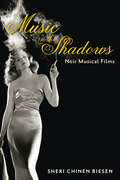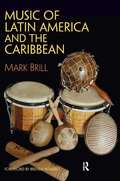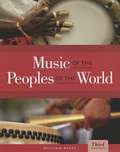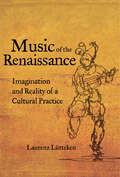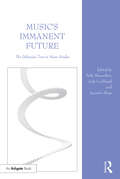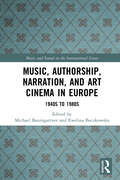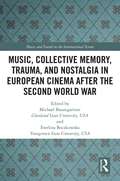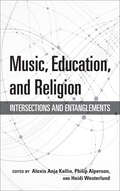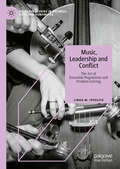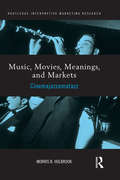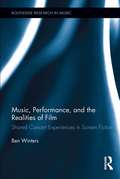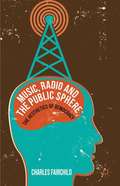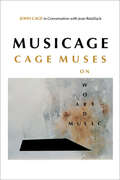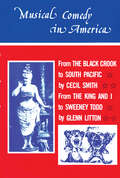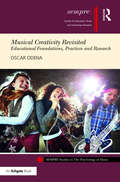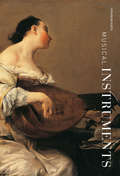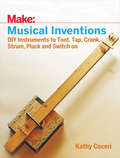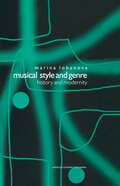- Table View
- List View
Music in the Horror Film: Listening to Fear
by Neil LernerMusic in Horror Film is a collection of essays that examine the effects of music and its ability to provoke or intensify fear in this particular genre of film. Frightening images and ideas can be made even more intense when accompanied with frightening musical sounds, and music in horror film frequently makes its audience feel threatened and uncomfortable through its sudden stinger chords and other shock effects. The essays in this collection address the presence of music in horror films and their potency within them. With contributions from scholars across the disciplines of music and film studies, these essays delve into blockbusters like The Exorcist, The Shining, and The Sixth Sense together with lesser known but still important films like Carnival of Souls and The Last House on the Left. By leading us with the ear to hear these films in new ways, these essays allow us to see horror films with fresh eyes.
Music in the Shadows: Noir Musical Films
by Sheri Chinen BiesenSome musical films use film noir style and jazz to reveal the dark side of fame and the American Dream.Smoke. Shadows. Moody strains of jazz. Welcome to the world of "noir musical" films, where tormented antiheroes and hard-boiled musicians battle obsession and struggle with their music and ill-fated love triangles. Sultry divas dance and sing the blues in shrouded nightclubs. Romantic intrigue clashes with backstage careers. In her pioneering study, Music in the Shadows, film noir expert Sheri Chinen Biesen explores musical films that use film noir style and bluesy strains of jazz to inhabit a disturbing underworld and reveal the dark side of fame and the American Dream. While noir musical films like A Star Is Born include musical performances, their bleak tone and expressionistic aesthetic more closely resemble the visual style of film noir. Their narratives unfold behind a stark noir lens: distorted, erratic angles and imbalanced hand-held shots allow the audience to experience a tortured, disillusioned perspective.While many musicals glamorize the quest for the spotlight in Hollywood's star factory, brooding noir musical films such as Blues in the Night, Gilda, The Red Shoes, West Side Story, and Round Midnight stretch the boundaries of film noir and the musical as film genres collide. Deep shadows, dim lighting, and visual composition evoke moodiness, cynicism, pessimism, and subjective psychological points of view.As in her earlier study of film noir, Blackout: World War II and the Origins of Film Noir, Biesen draws on extensive primary research in studio archives to situate her examination within a historical, industrial, and cultural context.
Music in the Shadows: Noir Musical Films
by Sheri Chinen BiesenAn analysis of Hollywood films that blend elements of musicals and film noir, from the author of Blackout: World War II and the Origins of Film Noir.Welcome to the world of “noir musical” films, where tormented antiheroes and hard-boiled musicians battle obsession and struggle with their music and ill-fated love triangles. Sultry divas dance and sing the blues in shrouded nightclubs. Romantic intrigue clashes with backstage careers.In her pioneering study, Music in the Shadows, film noir expert Sheri Chinen Biesen explores musical films that use film noir style and jazz to inhabit a disturbing underworld and reveal the dark side of fame and the American Dream. While noir musical films like A Star Is Born (1954) include musical performances, their bleak tone and expressionistic aesthetic more closely resemble the visual style of film noir. Their narratives unfold behind a stark noir lens: distorted, erratic angles and imbalanced hand-held shots allow the audience to experience a tortured, disillusioned perspective.While many musicals glamorize the quest for the Hollywood spotlight, brooding noir musical films such as Blues in the Night, Gilda, The Red Shoes, West Side Story, and Round Midnight stretch the boundaries of film noir and the musical as film genres collide. Deep shadows, dim lighting, and visual composition evoke moodiness, cynicism, pessimism, and subjective psychological points of view.Biesen draws on extensive primary research in studio archives to situate her examination within a historical, industrial, and cultural context.“Biesen builds a fascinating and quite convincing case for a genre hybrid, the noir musical, that took root in the 1940s but has continued to evolve ever since.” —Thomas Schatz, The University of Texas at Austin
Music of Latin America and the Caribbean
by Mark BrillThe Music of Latin America and the Caribbean is the first text written on the rich musical heritage of this region specifically for the non-music major. The text is arranged by region, focusing on the major countries/regions (Mexico, Brazil, Peru, etc. in Latin America and Jamaica, the Virgin Islands, Haiti, etc. in the Caribbean). In each chapter, the author gives a complete history of the region's music, ranging from classical and classical-influenced styles to folk and traditional music to today's popular music.
Music of the Peoples of the World (Third Edition)
by William AlvesThis book emphasizes the necessity of understanding music and its culture, and draws on diverse perspectives to guide the student, including music theory, musicology and ethnomusicology.
Music of the Renaissance: Imagination and Reality of a Cultural Practice
by Laurenz LüttekenWhere previous accounts of the Renaissance have not fully acknowledged the role that music played in this decisive period of cultural history, Laurenz Lütteken merges historical music analysis with the analysis of the other arts to provide a richer context for the emergence and evolution of creative cultures across civilizations. This fascinating panorama foregrounds music as a substantial component of the era and considers musical works and practices in a wider cultural-historical context. Among the topics surveyed are music's relationship to antiquity, the position of music within systems of the arts, the emergence of the concept of the musical work, as well as music's relationship to the theory and practice of painting, literature, and architecture. What becomes clear is that the Renaissance gave rise to many musical concepts and practices that persist to this day, whether the figure of the composer, musical institutions, and modes of musical writing and memory.
Music's Immanent Future: The Deleuzian Turn in Music Studies
by Jennifer Shaw Sally Macarthur Judy LochheadThe conversations generated by the chapters in Music's Immanent Future grapple with some of music's paradoxes: that music of the Western art canon is viewed as timeless and universal while other kinds of music are seen as transitory and ephemeral; that in order to make sense of music we need descriptive language; that to open up the new in music we need to revisit the old; that to arrive at a figuration of music itself we need to posit its starting point in noise; that in order to justify our creative compositional works as research, we need to find critical languages and theoretical frameworks with which to discuss them; or that despite being an auditory system, we are compelled to resort to the visual metaphor as a way of thinking about musical sounds. Drawn to musical sound as a powerful form of non-verbal communication, the authors include musicologists, philosophers, music theorists, ethnomusicologists and composers. The chapters in this volume investigate and ask fundamental questions about how we think, converse, write about, compose, listen to and analyse music. The work is informed by the philosophy primarily of Gilles Deleuze and Felix Guattari, and secondarily of Michel Foucault, Julia Kristeva and Jean-Luc Nancy. The chapters cover a wide range of topics focused on twentieth and twenty-first century musics, covering popular musics, art music, acousmatic music and electro-acoustic musics, and including music analysis, music's ontology, the noise/music dichotomy, intertextuality and music, listening, ethnography and the current state of music studies. The authors discuss their philosophical perspectives and methodologies of practice-led research, including their own creative work as a form of research. Music's Immanent Future brings together empirical, cultural, philosophical and creative approaches that will be of interest to musicologists, composers, music analysts and music philosophers.
Music, Authorship, Narration, and Art Cinema in Europe: 1940s to 1980s (Music and Sound on the International Screen)
by Michael Baumgartner Ewelina BoczkowskaMusic, Authorship, Narration, and Art Cinema in Europe: 1940s to 1980s investigates the function of music in European cinema after the Second World War up to the fall of the Berlin wall, a period when composers and directors embraced experimentation. Through analyses of music and sound in a wide range of iconic films from across Europe, the essays in this book provide a nuanced reconsideration of three core themes: auteur theory, art house film, and national cinema. Chapters written by an international array of contributors focus on case studies of music in the cinema of Carlos Saura, Jean-Pierre Melville, the Polish School, and Romanian directors, as well as collaborations between directors and composers, including Michelangelo Antonioni and Giovanni Fusco, Federico Fellini and Nino Rota, Leo Arnshtam and Dmitry Shostakovich, and Peter Greenaway and Michael Nyman. The contributors shift the emphasis from a director-centered view to the working relationship between director and composer, and from the visual component to the sonic aspects of these films, without ignoring the close correlation between soundtrack and visual elements. Enriching our understanding of the complex, intertwined nature of authorship in film, the role of film music, and sound, nation-state and art cinema, and European cinematic history, this volume offers a valuable addition to research across music and film studies.
Music, Collective Memory, Trauma and Nostalgia in European Cinema after the Second World War (Music and Sound on the International Screen)
by Michael Baumgartner Ewelina BoczkowskaIn the wake of World War II, the arts and culture of Europe became a site where the devastating events of the 20th century were remembered and understood. Exploring one of the most integral elements of the cinematic experience—music—the essays in this volume consider the numerous ways in which post-war European cinema dealt with memory, trauma and nostalgia, showing how the music of these films shaped the representation of the past. The contributors consider films from the United Kingdom, Poland, the Soviet Union, France, Italy, Germany, and the Netherlands, providing a diverse and well-rounded understanding of film music in the context of historical memory. Memory is often underrepresented within scholarly musical studies, with most of these applications found in the disciplines of ethnomusicology, popular music studies, music cognition, and psychology and music therapy. Likewise, trauma has mainly been studied in relation to music in only a few historical contexts, while nostalgia has attracted even less academic attention. In three parts, this volume addresses each area of study as it relates to the music of European cinema from 1945 to 1989, applying an interdisciplinary approach to investigate how films use music to negotiate the precarious relationships we maintain with the past. Music, Collective Memory, Trauma and Nostalgia in European Cinema after the Second World War offers compelling arguments as to what makes music such a powerful medium for memory, trauma and nostalgia.
Music, Education, and Religion: Intersections and Entanglements (Counterpoints: Music and Education)
by Edited by Alexis Anja Kallio, Philip Alperson, and Heidi WesterlundEssays examining the role of religion in music education from a variety of perspectives.Music, Education, and Religion: Intersections and Entanglements explores the critical role that religion can play in formal and informal music education. As in broader educational studies, research in music education has tended to sidestep the religious dimensions of teaching and learning, often reflecting common assumptions of secularity in contemporary schooling in many parts of the world. This book considers the ways in which the forces of religion and belief construct and complicate the values and practices of music education—including teacher education, curriculum texts, and teaching repertoires. The contributors to this volume embrace a range of perspectives from a variety of disciplines, examining religious, agnostic, skeptical, and atheistic points of view. Music, Education, and Religion is a valuable resource for all music teachers and scholars in related fields, interrogating the sociocultural and epistemological underpinnings of music repertoires and global educational practices.&“The book serves as a study volume for all those who are active in this field and provides both systematic reflections and useful empirical studies. A further impressive feature is the regional and religious breadth of the content presented and examined.&” —Wolfgang W. Müller, Reading Religion
Music, Leadership and Conflict: The Art of Ensemble Negotiation and Problem-Solving (Palgrave Studies in Business, Arts and Humanities)
by Linda M. IppolitoThis book is the first in the field to explore the use of music in negotiation, conflict resolution and leadership development. Presenting grounded empirical data, it examines how adopting an ensemble approach to negotiation and problem-solving might assist in shifting adversarial combative and competitive frames towards a collaborative mindset. The book introduces a music-based cognitive metaphor and music-based pedagogy into the study of negotiation and problem-solving, considering the impact of arts-based learning strategies on the theory and practice of dispute resolution and enriching readers’ understanding of the design and implementation of such strategies. Specifically focused upon the rise of arts-based learning in professional business management education and training, this book explores the need for foundational change in conflict culture and leadership development, and how we might achieve it.
Music, Movies, Meanings, and Markets: Cinemajazzamatazz (Routledge Interpretive Marketing Research)
by Morris HolbrookMusic, Movies, Meanings, and Markets focuses on macromarketing-related aspects of film music in general and on the cinemusical role of ambi-diegetic jazz in particular. The book examines other work on music in motion pictures which has dealt primarily with the traditional distinction between nondiegetic film music (background music that comes from off-screen and is not audible to the film’s characters, to further the dramatic development of plot, character, or other themes) and diegetic music (source music produced on-screen and/or that is audible to the film’s characters, adding to the realism of the mise-en-scène without contributing much to other dramatic meanings). This book defines, describes, and illustrates another hitherto-neglected type of film music –ambi-diegetic film music, which appears on-screen but which contributes to the dramatic development of plot, character, and other themes. Consistent with an interest in macromarketing, such ambi-diegetic film music serves as a kind of product placement (suitable for commercialization via the cross-promotion of soundtrack albums, for example) and plays a role in product design. It also provides one type of symbolic consumer behavior that indicates choices made by film characters when playing-singing-listening-or-dancing in ways that reveal their personalities or convey other cinemusical meanings. Morris Holbrook argues that ambi-diegetic film music sheds light on various social issues –such as the age-old tension between art and entertainment as it applies to the contrast between creative integrity and commercialization. Music, Movies, Meanings, and Markets explores the ways in which ambi-diegetic jazz contributes to the development of dramatic meanings in various films, many of which address the art-versus-commerce theme as a central concern.
Music, Performance, and the Realities of Film: Shared Concert Experiences in Screen Fiction (Routledge Research in Music)
by Ben WintersThis book examines the relationship between narrative film and reality, as seen through the lens of on-screen classical concert performance. By investigating these scenes, wherein the performance of music is foregrounded in the narrative, Winters uncovers how concert performance reflexively articulates music's importance to the ontology of film. The book asserts that narrative film of a variety of aesthetic approaches and traditions is no mere copy of everyday reality, but constitutes its own filmic reality, and that the music heard in a film's underscore plays an important role in distinguishing film reality from the everyday. As a result, concert scenes are examined as sites for provocative interactions between these two realities, in which real-world musicians appear in fictional narratives, and an audience’s suspension of disbelief is problematised. In blurring the musical experiences of onscreen observers and participants, these concert scenes also allegorize music’s role in creating a shared subjectivity between film audience and character, and prompt Winters to propose a radically new vision of music’s role in narrative cinema wherein musical underscore becomes part of a shared audio-visual space that may be just as accessible to the characters as the music they encounter in scenes of concert performance.
Music, Radio and the Public Sphere
by Charles FairchildRadio, the most widely used medium in the world, is a dominant mediator of musical meaning. Through a combination of critical analysis, interdisciplinary theory and ethnographic writing about community radio, this book provides a novel theorization of democratic aesthetics, with important implications for the study of old and new media alike.
Musicage: Cage Muses on Words, Art, Music
by Joan Retallack John Cage"I was obliged to find a radical way to work -- to get at the real, at the root of the matter," John Cage says in this trio of dialogues, completed just days before his death. His quest for the root of the matter led him beyond the bounds of the conventional in all his musical, written, and visual pieces. The resulting expansion of the definition of art -- with its concomitant emphasis on innovation and invention -- earned him a reputation as one of America's most influential contemporary artists. Joan Retallack's conversations with Cage represent the first consideration of his artistic production in its entirety, across genres. Informed by the perspective of age, Cage's comments range freely from his theories of chance and indeterminate composition to his long-time collaboration with Merce Cunningham to the aesthetics of his multimedia works. A composer for whom the whole world -- with its brimming silences and anarchic harmonies -- was a source of music, Cage once claimed, "There is no noise, only sounds." As these interviews attest, that penchant for testing traditions reached far beyond his music. His lifelong project, Retallack writes in her comprehensive introduction, was "dislodging cultural authoritarianism and gridlock by inviting surprising conjunctions within carefully delimited frameworks and processes." Consummate performer to the end, Cage delivers here just such a conjunction -- a tour de force that provides new insights into the man and a clearer view of the status of art in the 20th century.
Musical Comedy in America: From The Black Crook to South Pacific, From The King & I to Sweeney Todd
by Cecil A. Smith Glenn LittonFirst Published in 1987. Routledge is an imprint of Taylor & Francis, an informa company.
Musical Creativity Revisited: Educational Foundations, Practices and Research (SEMPRE Studies in The Psychology of Music)
by Oscar OdenaHow is creativity understood and facilitated across music education settings? What is the power of creativity in enhancing individual and group learning? How is musical creativity used as a tool for cross-community integration? How can we research the interactions of those engaged in musical activities aimed at creative development? These are just some of the questions addressed in this fascinating new monograph. Musical Creativity Revisited is an authoritative volume of insights from theory, practice-based research and methodological analyses. Its chapters celebrate the diversity of the many different ways in which young and adult learners develop musical creativity. Following on from Musical Creativity: Insights from Music Education Research (Ashgate, 2012) Odena offers novel examples from practice and precise suggestions on how to research it. This book will be an essential point of reference for students, researchers, practitioners and practitioner-researchers interested in music education and creativity across the arts and social sciences. The chapters have been organized into three sections – Foundations, Practices and Research – including examples from in-depth studies focussed on a secondary school in England, higher music education in Spain and out-of-school settings in Northern Ireland. This is a book that will fascinate readers, inspiring them to think deeply about the many different ways in which musical creativity can be developed, its purposes and how to research it.
Musical Instruments
by Darcy KuronenEnhanced with twenty-five audio and twenty-three video clips of expert musicians performing on rare and historical instruments, this e-book edition of Musical Instruments brings the world-renowned collection at the Museum of Fine Arts, Boston, to life. Musical instruments are among the most meaningful artifacts produced by humankind, a marriage of technology, artistry, symbolism, religion, and entertainment. This title in the MFA Highlights series presents more than a hundred examples, spanning a breadth of centuries and cultures, to invite readers to experience a brilliant array of instruments as producers of both aural and visual delight. The pieces included here - which range from an ancient Greek trumpet to a modern lap steel guitar, and from earthenware panpipes to the complex Indonesian gamelan - are remarkable not only for the myriad sounds they produce, but also for their varied and often extraordinarily beautiful appearance. Musical Instruments offers a vivid encounter with a rich collection, enhanced to provide an accessible and fascinating introduction to the artistry and significance of musical instruments around the world.ABOUT THE AUTHORDarcy Kuronen is Department Head and Pappalardo Curator of Musical Instruments at the Museum of Fine Arts, Boston.
Musical Instruments
by Darcy KuronenEnhanced with twenty-five audio and twenty-three video clips of expert musicians performing on rare and historical instruments, this e-book edition of Musical Instruments brings the world-renowned collection at the Museum of Fine Arts, Boston, to life. Musical instruments are among the most meaningful artifacts produced by humankind, a marriage of technology, artistry, symbolism, religion, and entertainment. This title in the MFA Highlights series presents more than a hundred examples, spanning a breadth of centuries and cultures, to invite readers to experience a brilliant array of instruments as producers of both aural and visual delight. The pieces included here - which range from an ancient Greek trumpet to a modern lap steel guitar, and from earthenware panpipes to the complex Indonesian gamelan - are remarkable not only for the myriad sounds they produce, but also for their varied and often extraordinarily beautiful appearance. Musical Instruments offers a vivid encounter with a rich collection, enhanced to provide an accessible and fascinating introduction to the artistry and significance of musical instruments around the world.ABOUT THE AUTHORDarcy Kuronen is Department Head and Pappalardo Curator of Musical Instruments at the Museum of Fine Arts, Boston.
Musical Inventions: DIY Instruments to Toot, Tap, Crank, Strum, Pluck, and Switch On
by Kathy CeceriPeople have been playing music on homemade instruments for thousands of years. But creating new instruments is much more than an art form. When you want to make a note sound higher or lower, you have to change the sound waves coming out of the instrument. That's science! When you explore the way different materials produce different sounds, that's engineering. When you speed up or slow down a song, you're counting beats -- using math. And technology makes electronic instruments and devices to record and play back music possible.
Musical Style and Genre: History and Modernity
by Marina LobanovaFirst published in 2000. Routledge is an imprint of Taylor & Francis, an informa company.
Musical Theater: An Appreciation (2nd Edition)
by Alyson McLamore<p>Musical Theater: An Appreciation, Second Edition offers a history of musical theater from its operating origins to the Broadway shows of today, combined with an in-depth study of the musical styles that paralleled changes on stage. Alyson McLamore teaches readers how to listen to both the words and the music of the stage musical, enabling them to understand how all the components of a show interact to create a compelling experience for audiences. <p>This second edition has been updated with new chapters covering recent developments in the twenty-first century, while insights from recent scholarship on musical theater have been incorporated throughout the text. The musical examples discussed in the text now include detailed listening guides, while a new companion website includes plot summaries and links to audio of the musical examples. <p>From Don Giovanni to Hamilton, Musical Theater: An Appreciation both explores the history of musical theater and develops a deep appreciation of the musical elements at the heart of this unique art form.</p>
Musical Theatre Education and Training in the 21st Century
by Scott D. Harrison Jessica O'BryanMusical Theatre Education and Training in the 21st Century presents a wide range of viewpoints on the musical theatre profession. It brings together research from the UK, US, Australia, and beyond, providing an essential resource for educators, students, and all those involved in training for musical theatre. The research draws on best practice from creatives, producers, practising artists, and the academy to reveal a multiplicity of approaches and educational pathways for consideration by performers, educators, institutions, and the profession.The book goes beyond the key elements of performance training in singing, dancing, and acting to explore adjacent creative and business skills, along with some of the more recent and challenging aspects of the profession such as diversity of representation both on and off stage, building safe working environments, and managing mental and physical health and wellbeing. The authors incorporate information from over 100 interviews with everyone from emerging performers to leading professionals, and explore the practicalities of pre-professional training, skills development, and curricular design, alongside the broader attributes required in preparation for the profession. This book offers vital insights into how musical theatre practitioners can best be prepared to make their way in the field now and in the future.
Musical Theatre For Dummies
by Seth RudetskyDiscover what goes on behind the curtains of your favorite musical Have you ever dreamed of being in a Broadway musical, or even just to be in the ensemble in your local community theatre? In Musical Theater For Dummies, Broadway insider and host of Sirus/XM Radio’s ON BROADWAY channel Seth Rudetsky takes you backstage and shows you what it takes to create a spectacular production. You’ll get the behind-the-curtain view of how your favorite on- and off-Broadway shows are made, plus get expert advice on how to launch your own career under the bright lights. If you’re new to musical theater, this book will initiate you into the world of musicals by sharing the stories and lingo that defines this fascinating world. This unique book shares insights into what makes musical theatre tick and how you can enjoy a show from your seat in the audience or from the stage itself. Learn the history of musical theater and discover the shows born on Broadway or the West End that became cultural phenomena Trace the development of productions, from the idea stage all the way through opening night and beyond Enjoy theater productions more, thanks to deep insights into how theater is made Get insider advice on the skills you need to perform in professional or amateur musical theater productions Real-life anecdotes and excellent show recommendations will entertain and delight you as you become a musical theater know-it-all, with Dummies.
Musical Theatre for the Female Voice: The Sensation, Sound, and Science, of Singing
by Shaun AquilinaFemale musical theatre singers produce some of the most exciting and expressive singing an audience can experience. They also face a unique and specific set of issues when approaching their craft, from negotiating the registers of their voice to enable them to belt, to vocal health challenges such as premenstrual voice syndrome. This is the only book that offers a full and detailed guide to tackling those issues and to singing with full expression and technical excellence. Musical Theatre for the Female Voice covers the origin of singing in musicals, from the bel canto style of 300 years ago through to the latest developments in high belting, in shows such as Wicked and Waitress. It offers the reader exercises and methods that have been used to train hundreds of singers at some of the UK’s leading musical theatre training institutions and are underpinned by the latest academic research in journals on singing, psychology, and health. Every element of a singer's toolkit is covered from a female perspective, from breath and posture to character work and vocal health. This is an essential guidebook for female singers in musical theatre productions, either training at university or conservatory level or forging a career as professional triple-threat performers.
